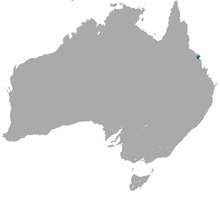| Proserpine rock-wallaby[1] | |
|---|---|
| Scientific classification | |
| Domain: | Eukaryota |
| Kingdom: | Animalia |
| Phylum: | Chordata |
| Class: | Mammalia |
| Infraclass: | Marsupialia |
| Order: | Diprotodontia |
| Family: | Macropodidae |
| Genus: | Petrogale |
| Species: | P. persephone
|
| Binomial name | |
| Petrogale persephone Maynes, 1982
| |

| |
| Proserpine rock-wallaby range | |
The Proserpine rock-wallaby (Petrogale persephone) is a species of rock-wallaby restricted to a small area in Conway National Park, Dryander National Park, Gloucester Island National Park, and around the town of Airlie Beach, all in Whitsunday Shire in Queensland, Australia. The etymology of the name is from Greek mythology in the form of the tale of Persephone, or Proserpine to the Romans, as well as from the location they were discovered. With its mythological background, the name symbolizes the fortuitous finding of the species at the beginning of spring and the restoration of knowledge of the species to mankind.[3] It is a threatened species, being classified by the IUCN as endangered.[2]
The Proserpine rock-wallaby is mostly grey in colour and is a timid grass-eater that rarely ventures far from rock shelter.[4] It is distinguished from the many other rock wallabies found in northeastern Queensland by its larger size and longer tail, tipped with white, distinct lack of pelage markings, incomplete ectoympanic ring not fused to posterior end of zygomatic arch, large pre-molars, and preference for deciduous vine forest habitats.[3][5] It was unknown to science until 1977, when a single individual was captured after farmers at Proserpine had spoken of a strange form of rock wallaby in the area.[6]
The Proserpine rock-wallaby is found only in a relatively intensively-settled area, but it is in competition with other more successful rock-wallaby species, which competition is probably responsible for its threatened status.[7]
Threats and Conservation
The Proserpine rock-wallaby is threatened by multiple factors. Its habitat has declined from increased urbanization and tourism, leading it vulnerable to road kill and predation from domestic dogs and cats.[5][8] Inbreeding and hybridization between the Prosperine and Unadorned rock-wallaby species also threatens the population.[2] It's feeding habits make it vulnerable to consuming introduced toxic plants like the pink periwinkle.[5]
Current conservation strategies for this species involve the acquisition of protected habitat, adding wildlife reflectors to roadkill zones to prevent further fatalities, and controlling toxic plants near their habitat.[9]
References
- ^ Groves, C. P. (2005). "Species Petrogale persephone". In Wilson, D. E.; Reeder, D. M (eds.). Mammal Species of the World: A Taxonomic and Geographic Reference (3rd ed.). Johns Hopkins University Press. p. 68. ISBN 978-0-8018-8221-0. OCLC 62265494.
- ^ a b c Burnett, S.; Winter, J. (2019). "Petrogale persephone". IUCN Red List of Threatened Species. 2019: e.T16747A21955635. doi:10.2305/IUCN.UK.2019-1.RLTS.T16747A21955635.en. Retrieved 19 November 2021.
- ^ a b Maynes, G.M. (1982-05-10). "A new species of rock-wallaby, Petrogale persephone (Marsupalia: Macropodidae), from Proserpine, central Queensland". Australian Mammology. 5 (1): 47–58. doi:10.1071/AM82005.
- ^ Menkhorst, Peter (2001). A Field Guide to the Mammals of Australia. Oxford University Press. p. 132-133. ISBN 019550870X.
- ^ a b c Nolan, Barry; Johnson, Peter (9 March 2001). "Proserpine Rock-wallaby (Petrogale persephone) Recovery Plan 2000-2004". Australian Government.
- ^ Karl Shuker; Gerald Durrell (1993). Lost Ark: New and Rediscovered Animals of the Twentieth Century. HarperCollins Publishers. p. 81. ISBN 0-00-219943-2.
- ^ Maynes, G.M.; Sharman, G.B. (1983). "Proserpine Rock-wallaby". In Ronald Strahan (ed.). The Complete Book of Australian Mammals. Oxford University Press. p. 220. ISBN 0207144540.
- ^ Eldridge, M. D. B.; Johnson, P. M.; Hensler, P.; Holden, J.; Close, R. L. K. (2008). "The distribution of three parapatric, cryptic species of rock-wallaby (Petrogale) in north-east Queensland: P. assimilis, P. mareeba and P. sharmani". Australian Mammalogy. 30 (1): 37–42. doi:10.1071/am08004. ISSN 1836-7402.
- ^ "Species Profile and Threats Database Petrogale persephone — Proserpine Rock-wallaby". Australian Government.
External links
- Australian Department of Environment and Heritage Species Profiles[permanent dead link]
- Animal Info on the Proserpine rock-wallaby
- https://web.archive.org/web/20070219182919/http://www.jcu.edu.au/school/tbiol/zoology/auxillry/mammals/prossy.htm (includes photos)

